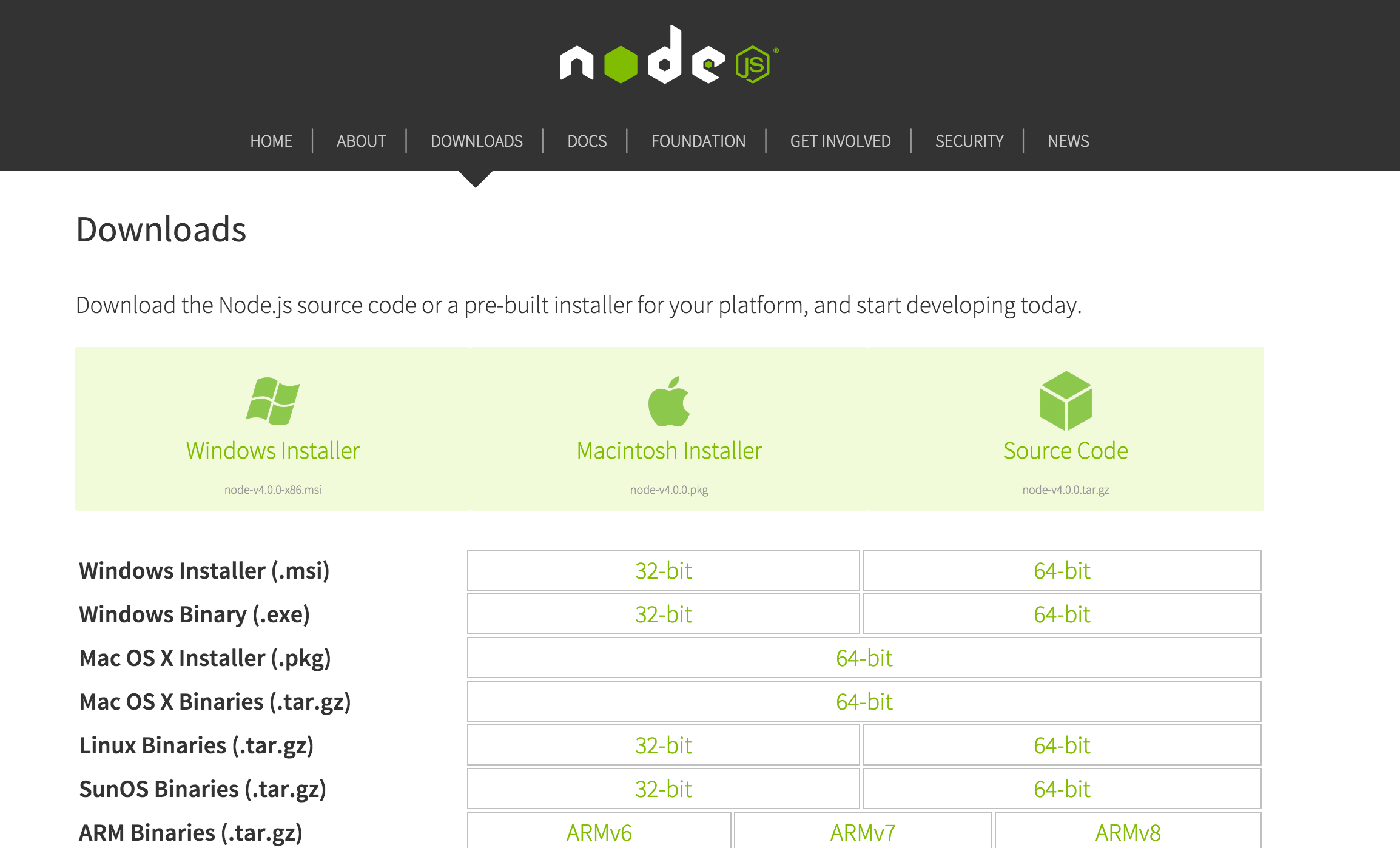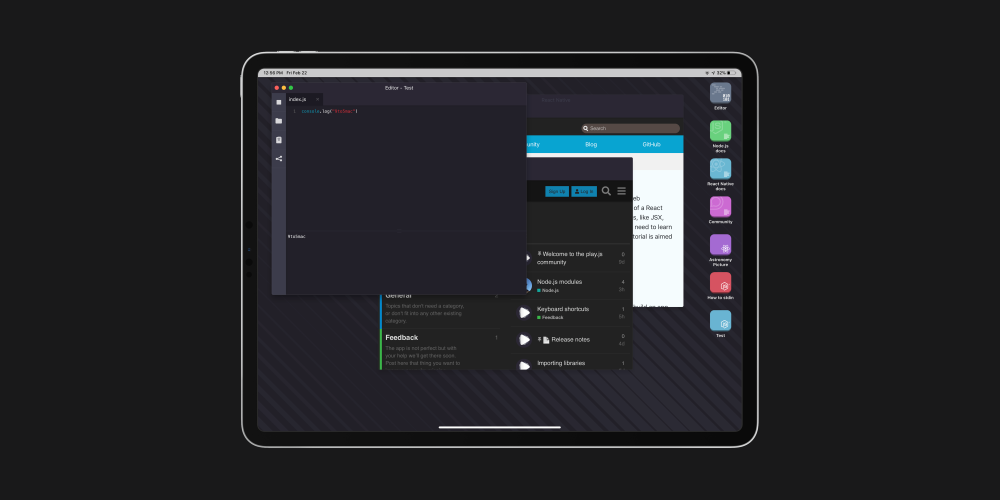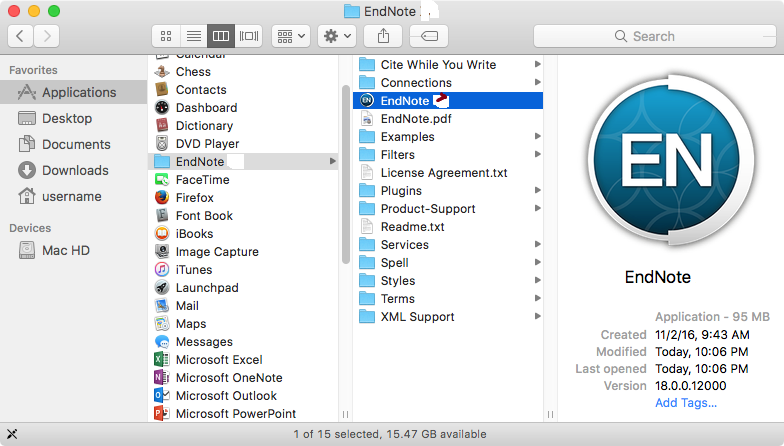Node Js For Mac
Posted : admin On 10/31/2019Node.js is a tool for building fast network applications. It’s known as a “JavaScript runtime environment” which simply means it lets you write JavaScript code that can run on your computer free of any web browser. Development is picking pace and Node.js is shipping out a new version frequently. It is nice to have the latest version at hand in your development environment to test out new features. There are a few ways to install Node.js. One of the obvious ones is to simply download the installer from nodejs. If you're on Windows, you can open Node.js command prompt to write code or if you're on Mac, simply open your terminal and write node. I'm going to write node and hit enter, I'm inside the node runtime where I can write any command of JavaScript.
I recently picked up a Yubico U2F hardware key and thought I’d try to create a web application that was protected with two-factor hardware-based authentication. Things were going smooth until I realized that it is mandatory to be using HTTPS within your application, even when testing locally. HTTPS is common, but I’d never actually set it up with Node.js because I had always been using services like Cloudflare that configure it for you. The problem is that these services are for live domain names, not necessarily localhost.
Node Js Ide For Mac
While we’re not going to explore U2F hardware keys in this tutorial, we’re going to take a look at creating and installing a self-signed certificate for use in Node.js within macOS.
Node.js and NPM on MacOS Since you are going to use JavaScript for your React development on MacOS, there is no way around Node.js and NPM. Node.js is a JavaScript runtime which makes it possible to run JavaScript outside of the browser. Node.js always ships with a specific version of npm - Node.js doesn't (and shouldn't!) automatically update npm. The npm releases aren't synced with Node.js releases. Because of this, there's almost always a newer version of npm than the one that is installed by default with a given version of Node. Node.js documentation: Install nvm on Mac OSX. Example INSTALLATION PROCESS. You can install Node Version Manager using git, curl or wget. Installing Node.js® and NPM on Mac What’s Node.js® and NPM? Node.js® is a JavaScript-based environment which you can use to create web-servers and networked applications. You can also use it to perform helpful tasks on your computer such as concatenating and minifying JavaScript files and compiling Sass files into CSS.
Creating a Self-Signed Certificate
Before we tell Node.js that we want to use a self-signed certificate for testing on localhost, we need to actually generate that certificate. If you’re on a Mac and you’ve already got your development tools installed like Xcode, you should already have the necessary command line tools to be successful.
From the command line, execute the following:
The Eclipse Foundation provides our global community of individuals and organizations with a mature, scalable and commercially-friendly environment for open source software collaboration and innovation. The Eclipse Foundation - home to a global community, the Eclipse IDE, Jakarta EE and over 350 open source projects, including runtimes, tools and frameworks. Eclipse for mac. Eclipse for Mac includes tools made to give developers the freedom of choice in a multi-language, multi-platform, and multi-vendor environment. Eclipse provides a plug-in based framework that makes it easier to create, integrate, and utilize software tools, saving time and money. By collaborating and exploiting core integration technology, tool. Uninstall Eclipse Using App Cleaner & Uninstaller. App Cleaner & Uninstaller is a software which helps to remove applications from a Mac completely. Thanks to its user-friendly interface, you can easily delete an app in less than a minute, instead of removing all files step by step. In this tutorial, we will learn how to install eclipse IDE on Mac OS X. Eclipse IDE (Integrated development environment) is written in Java and mostly used for developing Java applications. In Eclipse IDE, you can write, compile and run your Java code. Download and install Eclipse.
The above commands will do two different things. The first command will generate a private key to be used when creating your certificate in the second command. In the second command, we generate a certificate that expires after a a year. The above commands are not specific towards generating a localhost certificate, but they are for a self-signed certificate. To make the certificate localhost compatible, it is important that you use localhost as the common name when prompted by the second command.
Don’t lose the .key file and the .cert file as both will be necessary when configuring the Node.js application.
Installing the Certificate in the macOS Keychain
With the .cert file in hand, the next step is to install it as a trusted authority on macOS. To do this, you’ll need to open your Keychain application.
In the certificates tab, drag your .cert file into the window. You may be prompted to enter your computer password and if not, you will be prompted later.
With the certificate added, we need to change the trust so that way it is actually used by our web browsers. Double click on the certificate entry to be brought to a new window with the certificate information.
Because this certificate is self-signed for localhost testing, it is easiest to choose the dropdown and select to always trust what the certificate has to offer. If you are more comfortable choosing only what you need, go for it. When you close the window after making the change, you may be prompted to enter your password.
With the certificate generated and in place on macOS, we can work towards using it in Node.js.
Developing an HTTPS Secured API with Express Framework
We’re going to build an incredibly simple RESTful API with Express Framework that uses our self-signed certificate. If you’d like more information on creating APIs, you might check out my previous tutorial titled, Create a Simple RESTful API with Node.js, or even my in-depth eBook and video course, Web Services for the JavaScript Developer.
On your computer, create a new project directory and execute the following commands:
The above commands will create a new Node.js project and install the Express Framework package. What you’ll also need to do is create an app.js file or some other JavaScript file to hold our application logic. Within the app.js file, include the following:

If you’ve ever worked with an Express Framework API before, the above code should look very familiar. At the top you’ll notice that we’ve imported the https and fs dependencies, both of which are readily available out of the box in Node.js. We have a single endpoint, which will be served over HTTPS.
To make our application HTTPS, we need to use the https package and read the .key and .cert files from the disk. You’ll want to provide the path to your files because the above code assumes that both files exist in the same directory as the app.js file. Finally it might be a good idea to use the typical HTTPS port which is 443.
When you run this application and navigate to https://localhost/ in your web browser, Chrome or similar might throw an alert about the destination being unsafe. This is because we’re using a self-signed certificate and Chrome or similar might not recognize it as a safe authority. Go ahead and choose to proceed anyways because we know what we’re trying to accomplish.

Conclusion
You just saw how to generate, install, and use a self-signed certificate in your Node.js application running on localhost on a macOS computer. The process of installing a self-signed certificate may vary between Mac, Linux, and Windows, but the generation and usage in Node.js should be more or less the same.
If you want to expand what this tutorial has to offer when it comes to building web services, check out my eBook and video course titled, Web Services for the JavaScript Developer.
A video version of this tutorial can be found below.
Nic Raboy
Nic Raboy is an advocate of modern web and mobile development technologies. He has experience in Java, JavaScript, Golang and a variety of frameworks such as Angular, NativeScript, and Apache Cordova. Nic writes about his development experiences related to making web and mobile development easier to understand.
